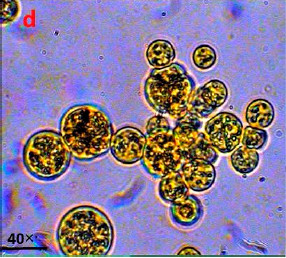- doi:10.1038/nchembio.2330
We’re in a love/hate relationship with flame retardants…
Daily, we encounter hundreds of products that contain flame retarding chemicals; these flame retardants (FRs) are added to furniture, clothing, textiles, electronics, and more to reduce the flammability of these consumer products. FRs are added to the surface of these products and can escape from their intended target, making their way into the environment, where they can enter food webs and bioaccumulate. One type of FR, called polybrominated diphenyl ethers (PBDEs), has been documented to negatively affect living creatures; PBDEs can disrupt thyroid function, impact how plants and animals grow and develop, or even cause behavioral or learning issues in children exposed to high levels of these compounds. All these negative impacts have earned PBDE industrial mixtures an international ban, eliminating ongoing production of these compounds.
Twinning: naturally produced versions of human-created chemicals
However, researchers from the University of California San Diego have identified another source of PBDEs in the environment: poriferans, aka sponges. These basic filter-feeding marine organisms produce complex chemical mixtures that include PBDE-like structures (called methoxylated PBDEs or MeO-PBDEs); limited research suggests that MeO-PBDEs have similar harmful effects to PBDEs. Sponges also house bacteria and other microorganisms that participate in secretion of the sponge chemical cocktail.

Up until this point, researchers knew that sponge communities (i.e. a sponge and its associated microbes) prolifically produced MeO-PBDEs, yet were unsure exactly how and where this production occurred. Vinayak Agarwal and his UCSD colleagues used some innovative analytical and genetic tools to better explain MeO-PBDE production in these intriguing invertebrates.
First question: what’s being produced?
First and foremost, the authors assessed the concentration of MeO-PBDEs in 18 sponge species collected over two years of sampling across Guam; they used liquid chromatography/ mass spectrometry techniques, along with nuclear magnetic resonance techniques to accomplish this. These two techniques deserve an article all their own to explain their use and importance, but suffice it to say these two methods separated the different components of each sponge’s chemical cocktail, and then determined the molecular structure of each contained compound. They determined that significant MeO-PBDE production was associated with specific groups, called clades, of sponges from the family Dysideidae.

Mining, not of the coal variety
From there, the group used a technique called metagenomic mining. Metagenomic mining is an overly scientific way to say they sequenced and assessed the total genetic material from their sponge samples; this means the sponge DNA as well as the DNA of symbionts associated with each sponge were sequenced. Symbionts are microbes that live intimately associated with a sponge, typically in a mutually beneficial relationship. The sequences were analyzed for genetic features, called clusters, that correlate to production of MeO-PBDEs.

Their analyses of genetic clusters revealed that microbial symbionts living in the sponge are responsible for the range of MeO-PBDE structures observed. Different sponge microbial symbionts, with variable gene clusters coding for MeO-PBDE production, translated to different produced MeO-PBDE structures by the sponge community.
Like Alien, but maybe less dramatic…
They further corroborated this conclusion by injecting specific gene clusters associated with MeO-PBDE production taken from sponge symbiotic microbes into unrelated, suitable bacteria hosts in an Alien style incubation. The dosed bacteria were then assessed for PBDE production after growth. Their above conclusion was supported, as the group found that cyanobacteria dosed with genes from sponge microbes produced MeO-PBDEs, and genes from different symbionts resulted in production of different structures.
So we have sponges that don’t light on fire or…?
Not quite. Sponges and their associated microbes use the produced flame retardant-like chemicals to avoid being lunch for a fish or avoid being overgrown by other invertebrates; these marine creatures aren’t readily at risk to be lit on fire. Yet these naturally created chemicals have other implications. MeO-PBDEs accumulate in the food web; marine mammals and other large sea creatures have been found with concentrations of naturally produced MeO-PBDEs much higher than any human created chemical. It’s not quite clear how harmful MeO-PBDEs may be within the food web, although it is known that they can degrade into toxic byproducts. In independent but related research, a group working in the San Francisco Bay found that the distribution of naturally produced pollutants similar to MeO-PBDEs may be changing due to climate change and other human impacts, yet this hypothesis isn’t clearly elucidated yet in other systems. Overall, little is known about MeO-PBDE production, food web impacts, and factors that alter production of these compounds. Agarwal’s work pinpointing one production pathway for these chemicals is therefore hugely important, as it helps to fill in the otherwise blank “who, what, when, where, and why” describing these natural pollutants and what they mean for marine food web health and function.
Moreover, many human drugs are created from marine natural products; understanding how these products are produced by marine organisms may help researchers more fluidly reproduce the synthesis of life-saving natural products into medicines or vaccines. Overall, these naturally produced chemicals are at the heart of some sensational and novel research, with continued excitement from this line of work likely.
I am a third year PhD student at the University of Rhode Island Graduate School of Oceanography in the Lohmann Lab. My current research interests include environmental chemistry, water quality, as well as coastal and seabird ecology. When not in the lab, I enjoy diving, surfing, and hanging out with my dog Gypsy.

